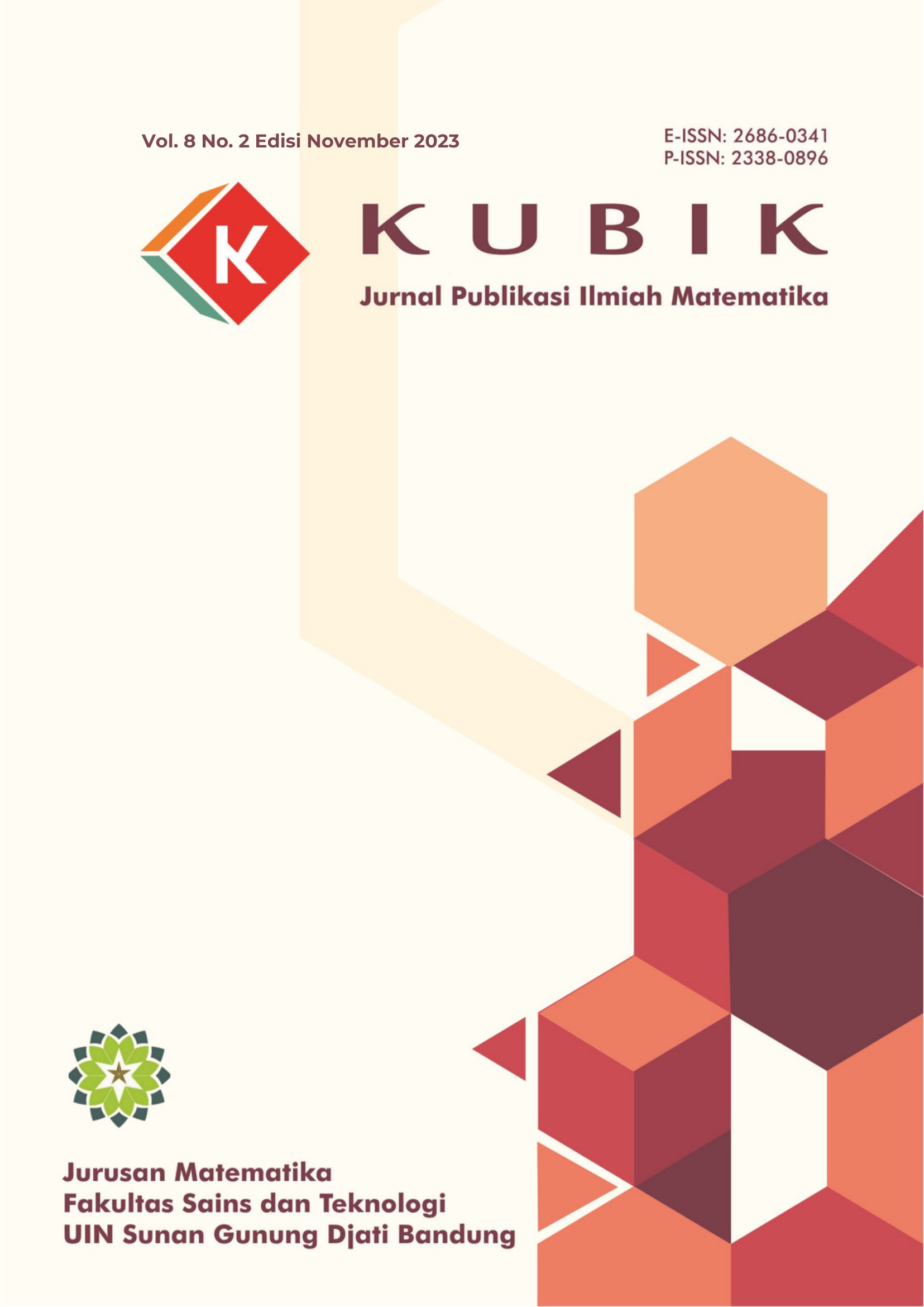Implementasi Metode Fuzzy Black-Scholes Real Options Valuation pada Rencana Investasi Smelter Nikel
DOI:
https://doi.org/10.15575/kubik.v8i2.29738Keywords:
real options, Black-Scholes, nickel smelter, fuzzyAbstract
Indonesia is the largest nickel producing country in the world in 2022 by contributing 48.48% of the world's total nickel production. Therefore, the Indonesian government pays attention to the development of smelter companies by planning to build around 53 companies in 2024, and 56.60 percent of them are nickel smelters. The potential of the nickel smelter needs attention from various circles, especially academics from various disciplines. One that needs attention is the study of the method of evaluating the economic value of the investment plan in the nickel smelter company. The DCF method, although practical and widely used, still has a drawback, which is that it does not pay attention to the flexibility of managers' decision-making in the middle of the ongoing investment period. As a solution, the real options valuation (ROV) method provides flexibility features in making these decisions. Among the real options methods that are often used is the Black-Scholes formula which is considered the most rigid but more practical real options method. However, this problem can be overcome by implementing the fuzzy number method into the ROV method, making it more flexible. The results of this study show that the fuzzy Black-Scholes ROV method is a practical method, can calculate the risks and projects flexibility, and become a solution when initial information is less available about the characteristics of nickel smelter investment projects.
References
H. Cheong, B. Kim, and I. U. Vaquero, “A Data Valuation Model to Estimate the Investment Value of Platform Companies: Based on Discounted Cash Flow,†J. Risk Financ. Manag., vol. 16, no. 6, p. 293, 2023, doi: 10.3390/jrfm16060293.
B. K. Laras Kemala and T. Simatupang, “Real Option Analysis Approach for Pharmaceutical Project Portfolio Optimization Model Considering Multi-project Dependencies,†2020 7th Int. Conf. Front. Ind. Eng. ICFIE 2020, pp. 40–47, 2020, doi: 10.1109/ICFIE50845.2020.9266740.
P. Jalaludin and K. P. Romantica, “Estimasi Nilai Proyek Bioteknologi dengan Metode Learning Options yang Dimodifikasi,†vol. 3, no. 1, 2023, [Online]. Available: https://journal.ebisma.net/index.php/ojs/article/view/30/26
P. Guj and A. Chandra, “Comparing different real option valuation approaches as applied to a copper mine,†Resources Policy, vol. 61. pp. 180–189, 2019. doi: 10.1016/j.resourpol.2019.01.020.
A. Çagri Tolga, C. Kahraman, and M. L. Demircan, “A comparative fuzzy real options valuation model using trinomial lattice and Black-Scholes approaches: A call center application,†J. Mult. Log. Soft Comput., vol. 16, no. 1–2, pp. 135–154, 2010, [Online]. Available: https://web.s.ebscohost.com/abstract?direct=true&profile=ehost&scope=site&authtype=crawler&jrnl=15423980&AN=48170285&h=FjmI7%2Bml62cV489SV46qWQOd7cJjhRuhASdF73SviJoam5JetYzt9I7X%2FDk5z%2BIJoOlLn4Uxk3F41zz8MwWqjQ%3D%3D&crl=c&resultNs=AdminWebAuth&resultLoc
F. Black and M. Scholes, “The pricing of opiions and corporate lîabililies.,†J. Polit. Econ., vol. 81, pp. 637–654, 1973, [Online]. Available: https://www.journals.uchicago.edu/doi/abs/10.1086/260062
S. A. Pratiwi, D. Rachmatin, and R. Marwati, “Distribution Based Fuzzy Time Series Markov Chain Models for forecasting Inflation in Bandung,†KUBIK J. Publ. Ilm. Mat., vol. 7, no. 1, pp. 11–18, 2022, doi: 10.15575/kubik.v7i1.18156.
F. Hanesti, W. Syafmen, and S. Rozi, “The Optimization Problem of Batik Cloth Production with Fuzzy Multi-Objective Linear Programming and Application of Branch and Bound Method,†KUBIK J. Publ. Ilm. Mat., vol. 7, no. 1, pp. 19–30, 2022, doi: 10.15575/kubik.v7i1.18432.
A. H. Nasyuha, M. Hutasuhut, and M. Ramadhan, “Penerapan Metode Fuzzy Mamdani Untuk Menentukan Stok Produk Herbal Berdasarkan Permintaan dan Penjualan,†J. Media Inform. Budidarma, vol. 3, no. 4, p. 313, 2019, doi: 10.30865/mib.v3i4.1354.
C. Carlsson and R. Fullér, “A fuzzy approach to real option valuation,†Fuzzy Sets Syst., vol. 139, no. 2, pp. 297–312, 2003, doi: 10.1016/S0165-0114(02)00591-2.
I. Uçal and C. Kahraman, “Fuzzy Real OptiOnS ValuatiOn FOR Oil inVeStmentS,†Technol. Econ. Dev. Econ., vol. 15, no. 4, pp. 646–669, 2009, doi: 10.3846/1392-8619.2009.15.646-669.
E. F. Santika, “Deretan Negara Penghasil Nikel Terbesar di Dunia pada 2022, Indonesia Nomor Satu!,†Databoks. Accessed: Sep. 15, 2023. [Online]. Available: https://databoks.katadata.co.id/datapublish/2023/03/02/deretan-negara-penghasil-nikel-terbesar-di-dunia-pada-2022-indonesia-nomor-satu
E. F. Santika, “Pemerintah Berambisi Bangun 53 Smelter pada 2024, Ini Rinciannya,†Databoks. Accessed: Sep. 15, 2023. [Online]. Available: https://databoks.katadata.co.id/datapublish/2023/04/27/pemerintah-berambisi-bangun-53-smelter-pada-2024-ini-rinciannya
M. K. E. Husin, A. P. Wibowo, and F. A. Rosyid, “Aplikasi Metode Evaluasi Ekonomi Real Option Pada Rencana Investasi Smelter Nickel Pig Iron,†Pros. Tpt Xxix Perhapi 2020, pp. 337–350, 2020, [Online]. Available: https://www.prosiding.perhapi.or.id/index.php/prosiding/article/view/165
BPS, “BI Rate 2023.†Accessed: Sep. 15, 2023. [Online]. Available: https://www.bps.go.id/indicator/13/379/1/bi-rate.html
Downloads
Additional Files
Published
How to Cite
Issue
Section
Citation Check
License
Authors who publish in KUBIK: Jurnal Publikasi Ilmiah Matematika agree to the following terms:
- Authors retain copyright and grant the journal right of first publication with the work simultaneously licensed under a Attribution-ShareAlike 4.0 International (CC BY-SA 4.0) License that allows others to share the work with an acknowledgment of the work's authorship and initial publication in this journal.
- Authors are able to enter into separate, additional contractual arrangements for the non-exclusive distribution of the journal's published version of the work (e.g., post it to an institutional repository or publish it in a book), with an acknowledgment of its initial publication in this journal.
- Authors are permitted and encouraged to post their work online (e.g., in institutional repositories or on their website) prior to and during the submission process, as it can lead to productive exchanges, as well as earlier and greater citation of published work (See The Effect of Open Access).
Â

